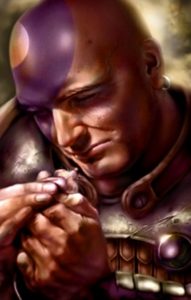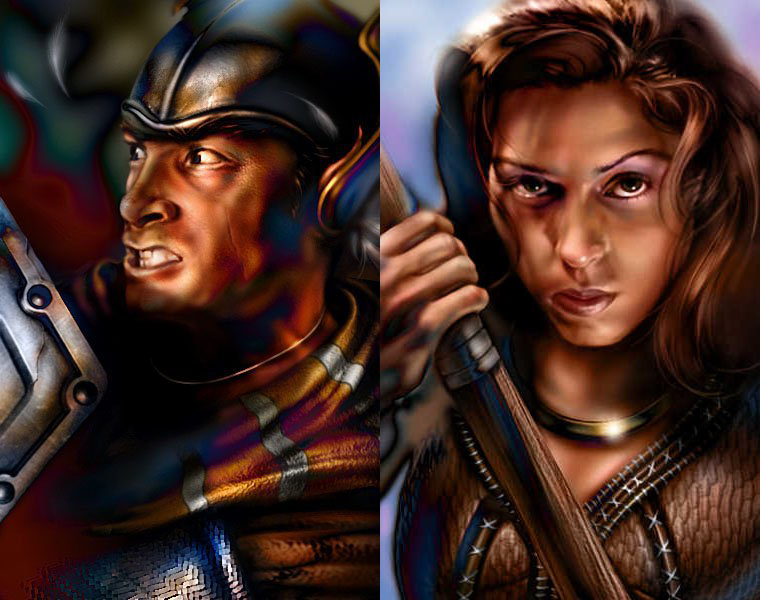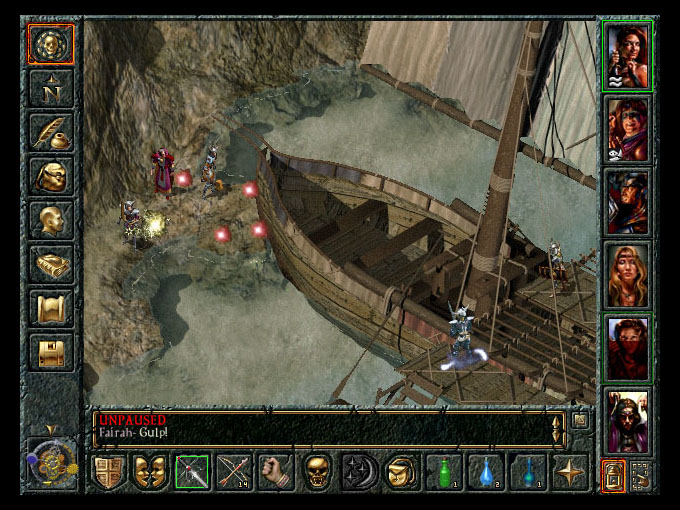Baldur’s Gate is the game I’ve played the most in my life, the one consistent pillar of my gaming history. There’s a clock constantly ticking in my head, a perpetual countdown to the next time I’ll be playing it. There’s now something reassuring about Baldur’s Gate for me, going back to the Sword Coast is almost therapeutic – I already know who’s going to be in my party (playing Baldur’s Gate without Khalid and Jaheira is not playing Baldur’s Gate), I already know I’m going to lose all my reputation by killing Drizzt to get his scimitars, I already know I’m going to pretend I won’t take the ring of wizardry that’s hidden outside the Friendly Arm Inn (because my brother told me when I was a kid that it’s “cheating” and it stuck with me) but I then won’t be able to resist it.
Knowing every nook and cranny of its universe already, you’d think I’d get bored of it after 20 years. But that’s the magic of Baldur’s Gate for me: it doesn’t get old. So when Skybound Games announced a partnership with Beamdog to bring the game to PS4, Xbox One and Switch later this year, I thought this was just the perfect opportunity to look back at what made the classic RPG so memorable. And Beamdog’s CEO and founder Trent Oster sounded like the perfect person to ask, being BioWare’s co-founder and part of the original 1998 Baldur’s Gate development team.

“I think first and foremost the key driver was to ensure we could capture the integrity of the Dungeons & Dragons rules,” he says when asked about the game’s key pillars. ”We understood that the whole system was very complex and that its character and its flavour came from that complexity. So we really wanted to wade into it and implement the rule system in such a way that it would behave as you would expect it to behave in pen and paper D&D sessions.
“Part of the driving force as well was to have a plausible and slightly more mature, almost politically-flavoured, plot. You could argue it’s not that plausible – I mean the guy is essentially trying to create a massive war so he can rise to become the Lord of Murder. But he’s doing it through political machinations. At that point fantasy stories were pretty soft. You were the hero, you did the thing, and in this game it was much more interesting… It’s a political thing, you’re investigating. There was also a strong desire to allow people to play the archetypes that they imagined, that they held high.”
This ability to play the game however you want, including as an evil character, is certainly part of the appeal. And then there’s what is, in my opinion, the most important pillar.
“I think another part was really having an interesting cast of fun and engaging characters,” Oster says. “The entire cast is actually characters from [Baldur’s Gate’s lead designer] James Ohlen’s pen and paper campaign that he ran – so my business partner Cameron [Tofer, Beamdog’s co-founder and former Baldur’s Gate programmer], his character was Minsc and one of the other guys his character was Sarevok and somebody had Edwin and somebody was Shar-Teel… All these characters came out of this pen and paper campaign.”
“There’s always that question of: is Boo a miniature hamster with an incredible intellect that’s directing this character or is the character quite mad?”
What made those characters engaging is they all had very unique personalities. Slow-witted, sweet but brutal Minsc for instance has to be one of the most memorable characters of the game – alongside his pet hamster Boo of course.

“I think one of the big things was coming up with kind of a theme and having every character stick to their core beliefs,” Oster comments when we start chatting about Minsc and how the team made the world and its characters feel alive. “So Minsc is not very smart but he wants to do good. He doesn’t really think through what doing good requires, he just does the obvious thing that he thinks will do good. So he’s almost like an arrow that just go straight after what he sees. He’s really consistent and he’s fun because of that. And there’s always that question of: is Boo a miniature hamster with an incredible intellect that’s directing this character or is the character quite mad? We’ve never really cleared that up,” Oster laughs.
I of course immediately ask if he wants to clear that up now, 20 years down the line: “Talking with James [Ohlen], because it’s his story and he kind of controls it, he never wanted to empirically speak out about it,” Oster starts with a smile. “But I get the feeling he was leaning toward Minsc being a little insane. But I think the big thing is that a lot of the characters were created with flawed statistics. So Khalid is a fighter but his strength is only 12 whereas when you roll a fighter you’re maxing your strength. So Khalid is this fighter but he’s not very strong and that kind of lends a lot to his character and dictates who he is whereas his partner Jaheira is very assertive, very set in her beliefs as to what is right. I think being able to stick consistently with these themes of how the characters view the world and how they behave in that world really added a sense of richness that really hadn’t been done before.”
LET’S DIAL IT BACK
With such a rich cast of potential party members and NPCs, nailing the game’s AI was instrumental.
“I’d hesitate to use the term AI when talking about Baldur’s Gate,” Oster laughs. “So Baldur’s Gate script – called BGScript – is kind of a reverse Polish notation and it’s hard. It takes a while for it to make sense but once it starts to make sense you’re able to get it to do actually reasonably advanced things considering it has no math. It can’t do any complex math. It’s essentially a big If-then statement and you just kind of process through it. So the scripts actually became quite complicated to just carry out what we wanted from advanced behaviours. And the funny thing is when we initially built the AI, it was too smart, it just tore the party apart. You’d get down to the bottom of the Nashkel Mines and you’d run into those Kobold commandos and they would target your spellcaster and boom, one turn down your spellcaster is dead, turn two the cleric’s dead… And it just destroyed the party and we were like: ‘Oh wow okay, let’s dial it back!’,” he laughs.
“I think the goal was that there were normal combats – where you would engage and it would be a satisfying combat experience. And then there would be more challenging, almost boss-like, fights. The boss fights would be like a puzzle where you had to deconstruct what was happening.”
What the team (and the AI) didn’t anticipate is so many players using the undead strategy: summoning lots and lots of skeletons in front of the target to serve as shields, with party members then using ranged weapons from a distance.

“I think that’s one of the strategies that we never thought of early on. We didn’t think about how many people would summon that many undead,” Oster confirms. “I think if I were to go back and rewrite it today I would specifically build an enemy just to take down the army of the dead defense – have a cleric that would just turn them all and suddenly they’re on their side,” he sniggers.
Another innovation Baldur’s Gate popularised at the time was pausable real-time combat, replacing the more traditional turn-based approach. And if this seems like a given for isometric RPGs now, it certainly wasn’t back in 1998.
“I think at the time we were really heavily influenced by Warcraft, we were playing a lot of it and it felt really good,” Oster starts explaining. “But when you threw a party in with the second edition D&D rules it turned into a hairball so fast, things were happening so quickly you couldn’t really control it. And we got talking about it and the feeling was that by going strictly turn-based it would just slow the gameplay down too much. So we kind of thought about it almost more like an [American] football game where it’s going and then you stop and you make a call, you make a play, and then the game continues on. As long as the game’s flowing well, don’t interrupt it. So that’s really kind of where the pause-in-play came out, it was us trying to keep the game flowing but at the same time trying to allow that additional element of tactics, thinking through your strategy and executing your strategy.”
HOW HARD COULD IT BE?
What makes BioWare’s success even more impressive with Baldur’s Gate, even 21 years after its release, is the fact that the team was inexperienced, with most of them having never shipped a game before. Oster worked on the studio’s debut title, Shattered Steel, before joining Baldur’s Gate’s development, making him one of the most experienced team members at the time.
“So there were a few of us, two or three, who moved on to help on Baldur’s Gate, who had actually shipped a game,” he recalls with a smile. “But at the same time it was our first game and we had just shipped it and it was radically different technology so we were all just a bunch of farm kids going; ‘Eh, how hard could it be to make a video game?’ and very quickly we were like: ‘Oh my god, it’s so hard!’,” he bursts out laughing.
On top of this, not only did the team have to build the game, but also its engine.

“At the time you didn’t really have a choice, if you wanted to make a game that was different than what was out there, you had to build the engine,” Oster says. “Baldur’s Gate actually grew out of a DirectDraw demo that Microsoft put out. So the very original concept was a game called Battleground Infinity and it was like a Ragnarok of all the various deities coming together for an end of days battle. And that was the rough concept behind it. Lead programmer Scott Greig took the DirectDraw sprite demo for drawing 2D sprites and he basically hacked into it so that you could run a character around and you could have these little AI creatures wandering around. In the demo all you could do was right click them and smite them and then they would die.
“So it was a very very primitive demo and when you look back at it it’s pretty staggering how Baldur’s Gate came out of that primitive thing but really the superpower of the Infinity Engine is that it was made by a team who is very Windows-centric, very database and data centric in terms of its approach. I mean historically video games have been made by very technical, hard core, hacker-y teams and this team was much more about data structure and really that’s what Baldur’s Gate does that other games didn’t do at the same period. Baldur’s Gate is throwing around hundreds of thousands of assets. There’s voice files, there’s scripts, there’s items, there’s sprites, there’s all these things that at a time when most games had 2,000 to 3,000 elements, Baldur’s Gate had 100,000 or more. And as a result that kind of data-centric architecture that everybody focused on at the start really allowed that capability. There was literally no other engine at the time that could have done a game like Baldur’s Gate.”
A HAPPY ACCIDENT
Needless to say that Baldur’s Gate was a learning moment for everyone involved, reinforced by its incredible critical and commercial success that lives on even 21 years later. When asked about what he learnt that helped him later on during his career, Oster answers: “I think the key learnings were that data really matters, that you really need to think about how you’re going to say things and how things are going to be accessed.
“And I think the other thing is to start with a fairly clear intent of what you want. Understand that you’re never going to know exactly what game you’re building when you start. But if you have an idea of what you want it to be, you can at least make little course corrections on the way there.

“One of the other key learnings probably is to aim high. Because sometimes it gets even better than what you think it could be. You have this idea: ‘Oh yeah, it’ll be like this, there will be this character, they’ll say some words, it’ll be fine’. And then, working with [Baldur’s Gate publisher] Interplay at the time, they brought in great voice actors, like Jim Cummings to do Minsc, and the first time we heard those voices in game, our concept of what the game could be grew so much. It was like: ‘Oh wow, rather than being just kind of neat, this could be amazing’.”
Overall, Oster wouldn’t change anything if he had to do it all over again, he says.
“Considering the team we had, considering the experience we had, I don’t think there’s a lot of things I would change. It was the right approach at the right time with the right people to make it happen. And I don’t know if people really realise how lucky we were to have all of those things kind of fall together at the right time. You had video games moving from 32-bit extended DOS to Windows 95. You had a database background team available to hire in Edmonton. You had an art team that had never made anything before kind of built piecemeal and educated by the School of Hard Knocks: trying to do it, failing, trying to do it again, failing.
“There is just so many little pieces that happened to come together at the right moment. I look back at it and if you changed one or two things, the whole game might fail. It’s just one of those amazing happy accidents that actually happened, we were lucky enough to pull it off and make a fun game that 20 years later people still enjoy.”

 MCV/DEVELOP News, events, research and jobs from the games industry
MCV/DEVELOP News, events, research and jobs from the games industry




